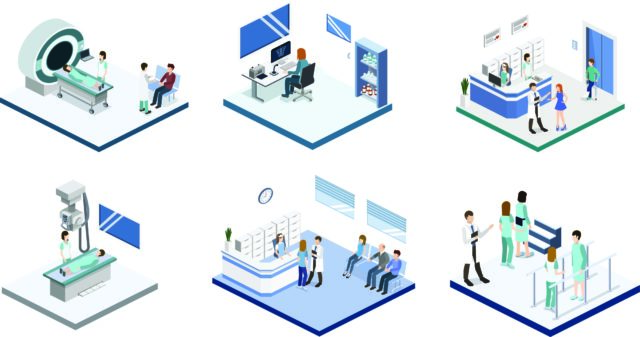BIM Equipment Placement – What is it and why is it important?
On most large healthcare design projects – and many small ones – medical equipment planners are an essential part of the design team. In addition to medical equipment planning services, Maia Consulting offers BIM equipment placement to streamline coordination and collaboration through the design process. While most healthcare architects can provide equipment placement services, many times they choose to subcontract the work to specialists. This is because medical equipment lists are so complex that drawing placement and change management become a burden on an architect whose time would be better spent focused on workflows and building design. When the latter is true, it is the right time to engage BIM equipment placement services for medical equipment planning.

What is BIM equipment placement for medical equipment planning?
Medical equipment is placed on architectural floor plans and elevations using the software program employed by the design architect. Revit and AutoCAD are the most widely used, with Revit being the most popular due to its BIM (Building Information Modeling) capabilities. The BIM planner is responsible for translating information about medical equipment placement and workflow into the architectural plans. This information is gathered through client user group meetings, inventories of existing spaces, design coordination meetings, and vendor site-specific drawings.
Revit families (or AutoCAD blocks) are placed in a live or static model and coordinated with the design team, equipment planners, and vendors to inform further user group discussions, identify potential conflicts, and finally provide information to the engineers and contractors who will ultimately construct the space. This coordination is an ongoing process which typically begins in Design Development (DD) and continues through Construction Documents (CD) and many times into Construction.
When is the right time to engage BIM equipment placement services?
Ideally, the BIM planner should start work toward the end of Schematic Design when typical rooms are set. If an equipment planner is involved in Pre-Design and has developed a preliminary equipment list by the end of Schematic Design, the BIM planner will populate typical rooms according to the equipment list. The typical room layouts are presented in the first Design Development meeting and adjusted based on user feedback as needed. Through the DD phase, more and more rooms are populated, reviewed, and updated until all rooms have been populated and locations confirmed.
Bringing a BIM planner into the design process early on avoids any coordination issues that could arise if ‘typical’ or ‘placeholder’ equipment were added to floor plans in place of the actual equipment.
What value does Maia Consulting offer through BIM equipment placement services?
Proper coordination and streamlined change management. Equipment specifications will be aligned with the Revit drawings up front and changes will be published in the ASE books and equipment models simultaneously. When a piece of equipment moves from one room to another, that change is reported and coordinated in the drawings at the same time as the updated equipment list is published.
Equipment locations determined with workflow in mind. With decades of experience placing medical equipment in healthcare spaces, our team is fluent in clinical workflow, giving thoughtful consideration to the way people operate within the spaces being designed while fostering flexibility.
Detailed Revit families. Our Revit families contain a level of detail that goes far beyond spatial orientation. Our Revit family library includes every type of equipment, with enough detail to be identifiable (a bed looks like a bed, an IV stand has wheels, etc). We also embed weight, electrical, plumbing, and ventilation requirements to facilitate MEP coordination between equipment layouts and construction documents.
We need a BIM equipment planner. What are the next steps?
Please contact us to discuss how Maia Consulting can support your healthcare design project.